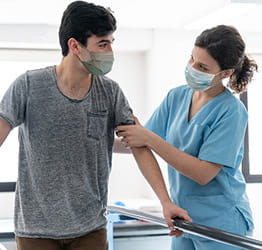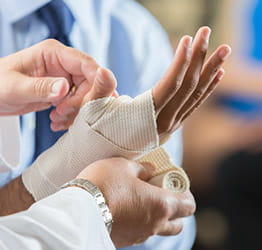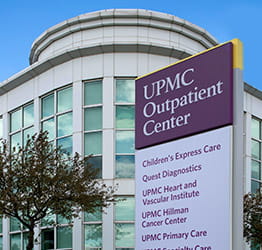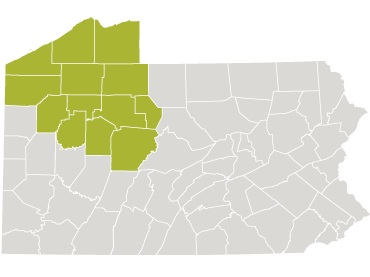
4/17/2025
PITTSBURGH – A multi-disciplinary team of UPMC clinicians has developed comprehensive clinical protocols for managing hospitalized patients exposed to xylazine—a veterinary sedative increasingly found in the unregulated opioid supply. Xylazine has been linked to severe and unique clinical complications, including difficult-to-manage withdrawal symptoms and necrotic skin ulcerations that are prone to infection and can develop into chronic, non-healing wounds.
Toxicology testing at UPMC revealed a five-fold increase in patient samples testing positive for xylazine between 2019 and 2021, underscoring the growing impact of this dangerous substance. In response, the UPMC team has created and implemented detailed treatment protocols, which are published this week in the Substance Use and Addiction Journal.
“With a rising number of patients presenting with these complex issues, particularly in regions like Western Pennsylvania, there is an urgent need for standardized, evidence-based and trauma-informed approaches to care,” said Raagini Jawa, M.D., MPH, FASAM, senior author, co-leader of the workgroup and infectious disease and addiction medicine physician.
Jawa and co-authors Margaret Shang, M.D., M.S., and Ilana Hull, M.D., M.Sc., all providers at UPMC Internal Medicine Recovery Engagement Program, have seen first-hand the effects on those exposed to xylazine. Funded by a UPMC Innovation Grant, the three physicians convened a group of clinicians from a wide variety of specialties, including addiction medicine, toxicology, emergency medicine, psychiatry and plastic surgery.
 “We were aware that there were many specialties trying to manage xylazine-related clinical harms in isolation and that the issue went beyond care provided by physicians alone,” said Hull, a family medicine and addiction medicine physician. “We needed a multidisciplinary group that also included pharmacists, nurses and hospital leadership to improve patient experience and outcomes.”
“We were aware that there were many specialties trying to manage xylazine-related clinical harms in isolation and that the issue went beyond care provided by physicians alone,” said Hull, a family medicine and addiction medicine physician. “We needed a multidisciplinary group that also included pharmacists, nurses and hospital leadership to improve patient experience and outcomes.”
Workgroup members drew on their varied clinical expertise and the best available information to create easy-to-follow guidelines for clinicians from admission to discharge and beyond, which were published internally in September 2024. The team also created and distributed patient education materials on wound care and harm reduction.
These guidelines help clinicians recognize symptoms earlier, coordinate multidisciplinary treatment more effectively, and manage complex wounds and withdrawal with greater confidence. While formal data collection is ongoing, early anecdotal feedback suggests improved patient outcomes, including better symptom control, reduced complications and smoother transitions to outpatient care. The protocols also help streamline care delivery and reduce variability, offering a critical tool for health systems responding to this growing public health challenge.
Their work offers a critical roadmap for other health systems nationwide, many of which are just beginning to encounter the widespread effects of xylazine in the opioid supply. This proactive approach aims to improve patient outcomes, reduce complications and prepare frontline providers for an evolving and increasingly dangerous landscape in substance use.
“Addiction providers should champion protocols and education,” said Shang. “We also need to empower patients to understand what is in the drug supply, the potential harms and how to seek treatment. Likewise, it’s important to engage patients so we can better understand barriers to care.”
Additional authors on the paper include Jane M. Liebschutz, M.D., M.P.H., Michael Abesamis, M.D., Michaely Lynch, M.D., Kenichi Tamama, M.D. Lauren Glikes, M.D., Payel J. Roy, M.D., M.Sc., Robert Leon-Barriera, M.D., Joshua Shulman, M.D., Krupa Patel, M.D., Danielle Heffner, M.D., Graciela Bauzá, M.D., Jennifer Rickens, P.A.-C., Simi Padival, M.D., J. Alex Viehman, M.D., Varidhi Nauriyal M.D., Gayle Gordillo, M.D., Teun Teunis, M.D., Nicole J. Jarrett, M.D., F.A.C.S., Matan Arnon, D.O., and Kristian Feterik M.D., M.B.A., all of Pitt; and Janine Then, Pharm.D., Joan Mapel, Pharm.D., Kimberly Baker, M.S.N., R.N., C.A.R.N., N.P.D.-B.C., Cecilia Zamarripa, Ph.D., R.N., C.W.O.N., and Eugenia Mangel, M.S.N., R.N., C.W.O.C.N., all of UPMC.
PHOTO DETAILS: (click images for high-res versions)
Top right photo
CAPTION: Workgroup co-leader Raagini Jawa, M.D., MPH, FASEM
CREDIT: UPMC
Left photo
CAPTION: Workgroup co-leader Ilana Hull, M.D., M.S.
CREDIT: UPMC
Bottom right photo
CAPTION: Workgroup co-leader Margaret Shang, M.D., M.Sc.
CREDIT: UPMC















